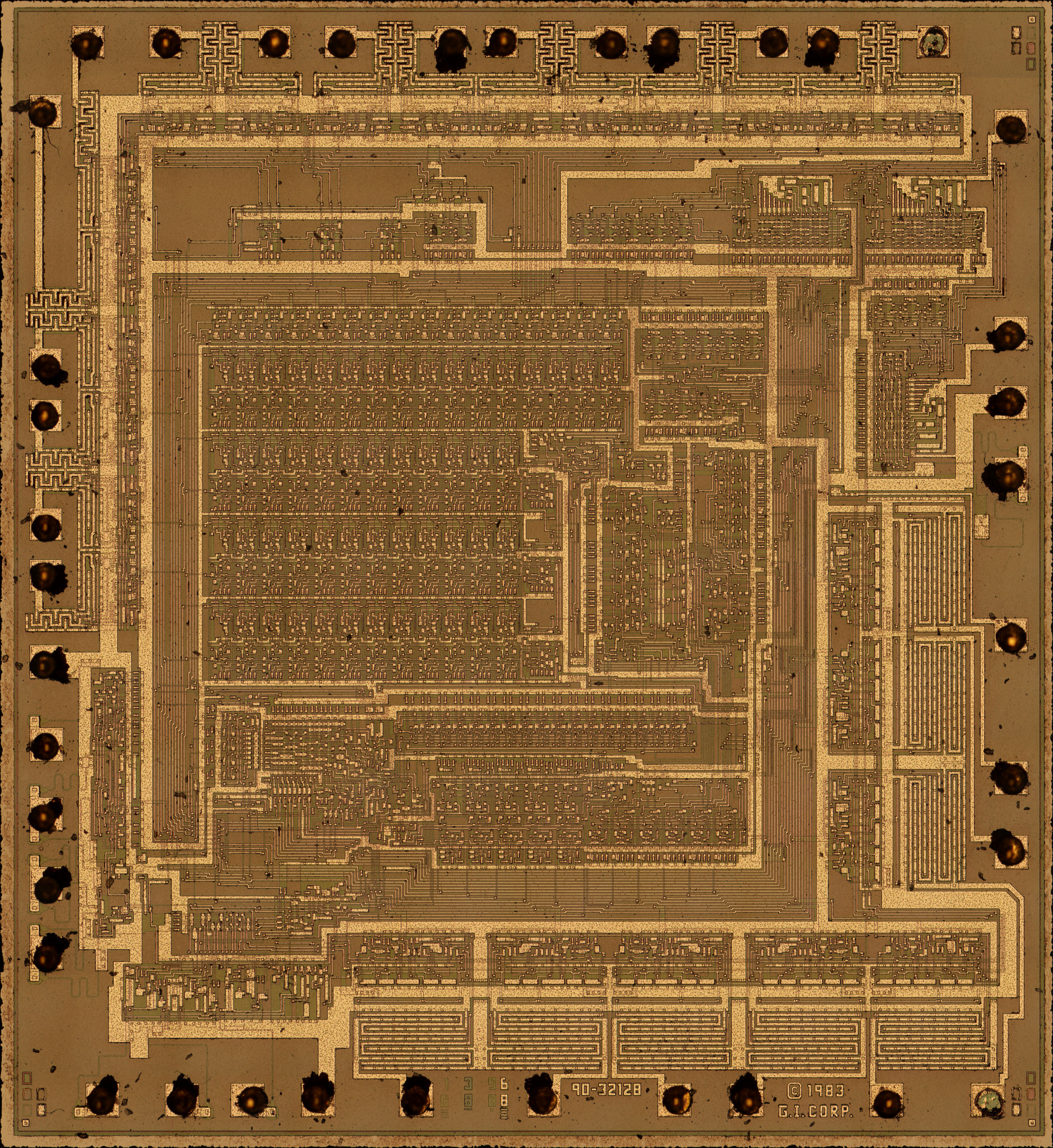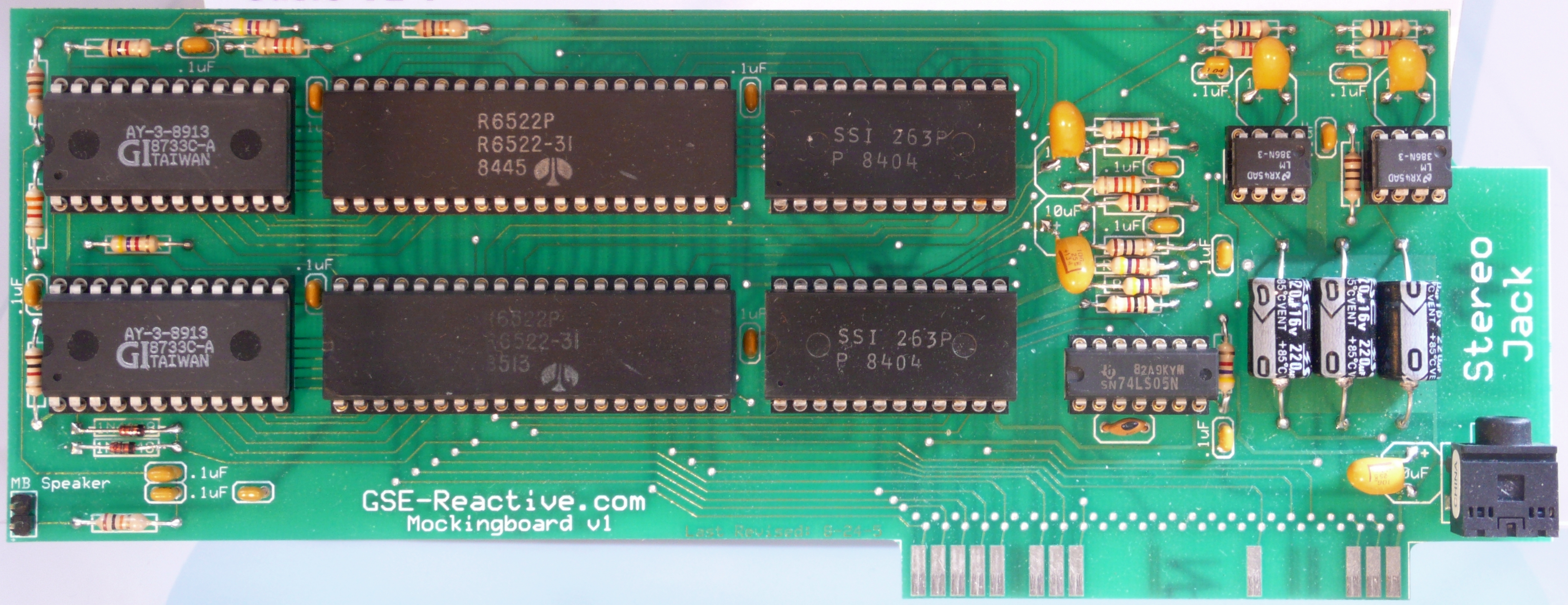|
AY-3-8912
The AY-3-8910 is a 3-voice programmable sound generator (PSG) designed by General Instrument (GI) in 1978, initially for use with their 16-bit CP1610 or one of the PIC1650 series of 8-bit microcomputers. The AY-3-8910 and its variants were used in many arcade games—Konami's ''Gyruss'' contains five—and Bally pinball machines as well as being the sound chip in the Intellivision and Vectrex video game consoles, and the Amstrad CPC, Oric-1, Colour Genie, Elektor TV Games Computer, MSX, Tiki 100 and later ZX Spectrum home computers. It was also used in the Mockingboard and Cricket sound cards for the Apple II and the Speech/Sound Cartridge for the TRS-80 Color Computer. After GI's spinoff of Microchip Technology in 1987, the chip was sold for a few years under the Microchip brand. It was also manufactured under license by Yamaha (with a selectable clock divider pin and a double-resolution and double-rate volume envelope table) as the YM2149F; the Atari ST uses th ... [...More Info...] [...Related Items...] OR: [Wikipedia] [Google] [Baidu] |
Oric-1
Oric was a brand of home computers sold in the 1980s by Tangerine Computer Systems. Tangerine was based in the United Kingdom and sold their computers primarily in Europe. All computers in the Oric line were based on the MOS Technology 6502A microprocessor. With the success of the ZX Spectrum from Sinclair Research, Tangerine's backers suggested a home computer and Tangerine formed Oric Products International Ltd to develop the Oric-1. The computer was introduced in 1982. During 1983, approximately 160,000 Oric-1 computers were sold in the UK, plus another 50,000 in France (where it was the year's top-selling machine). This resulted in Oric being acquired and given funding for a successor model, the 1984 Oric Atmos. Oric was bought by Eureka, which produced the less successful Oric Telestrat (1986). Oric was dissolved the year the Telestrat was released. Eastern European legal clones of Oric machines were produced into the 1990s. Models Oric-1 Based on a 1 MHz MO ... [...More Info...] [...Related Items...] OR: [Wikipedia] [Google] [Baidu] |
Tiki 100
Tiki-100 was a desktop home/personal computer manufactured by Tiki Data of Oslo, Norway. The computer was launched in the spring of 1984 under the original name Kontiki-100, and was first and foremost intended for the emerging educational sector, especially for primary schools. Early prototypes had 4 KB ROM, and the '100' in the machine's name was based on the total amount of memory in kilobytes. Development It was decided by the Norwegian government that Norwegian schools should all use the same standardized computer in education. The Tiki-100 was developed as a direct response to this decision, and was as such greatly influenced by the specifications laid out by the government. One of the most influential of these specifications was compatibility with CP/M and the Z80 CPU. Being designed as a computer intended for education, interactivity was prioritized. The machine was given good audiovisual capabilities for its time. While other educational computers at the time had a main ... [...More Info...] [...Related Items...] OR: [Wikipedia] [Google] [Baidu] |
Vectrex
The Vectrex is a vector display-based home video game console, the only one ever designed and released for the home market, that was developed by Smith Engineering and manufactured and sold by General Consumer Electronics. It was first released for the North America market in October 1982 and then Europe and Japan in 1983. Originally produced by General Consumer Electronics, it was later licensed to Milton Bradley after they acquired the company. Bandai released the system in Japan under the name 光速船, meaning Lightspeed. The Vectrex, in contrast to other video game systems at the time, did not need to be hooked up to a television set; it had an integrated (vertically oriented) monochrome CRT monitor. A detachable wired control pad could be folded into the lower base of the console. Games came with translucent color overlays to place over the screen. Optional peripherals include a pair of 3D goggles known as the "3D Imager" and a light pen for drawing directly on the screen ... [...More Info...] [...Related Items...] OR: [Wikipedia] [Google] [Baidu] |
Amstrad CPC
The Amstrad CPC (short for "Colour Personal Computer") is a series of 8-bit home computers produced by Amstrad between 1984 and 1990. It was designed to compete in the mid-1980s home computer market dominated by the Commodore 64 and the ZX Spectrum; it successfully established itself primarily in the United Kingdom, France, Spain, and the German-speaking parts of Europe, and also Canada. The series spawned a total of six distinct models: The ''Amstrad CPC 464, CPC 464'', ''CPC 664'', and ''CPC 6128'' were highly successful competitors in the European home computer market. The later ''464 plus'' and ''6128 plus'', intended to prolong the system's lifecycle with hardware updates, were considerably less successful, as was the attempt to repackage the ''plus'' hardware into a game console as the ''GX4000''. The CPC models' hardware is based on the Zilog Z80A CPU, complemented with either 64 or 128 KB of Random-access memory, RAM. Their computer-in-a-keyboard design prominently ... [...More Info...] [...Related Items...] OR: [Wikipedia] [Google] [Baidu] |
ZX Spectrum
The ZX Spectrum () is an 8-bit computing, 8-bit home computer developed and marketed by Sinclair Research. One of the most influential computers ever made and one of the all-time bestselling British computers, over five million units were sold. It was released in the United Kingdom on 23 April 1982, and around the world in the following years, most notably in Europe and the United States. The machine was designed by English entrepreneur and inventor Sir Clive Sinclair and his small team in Cambridge, and was manufactured in Dundee, Scotland by Timex Corporation. It was made to be small, simple, and most importantly inexpensive, with as few components as possible. The addendum "Spectrum" was chosen to highlight the machine's colour display, which differed from the black-and-white display of its predecessor, the ZX81. Rick Dickinson designed its distinctive case, rainbow motif, and chiclet keyboard, rubber keyboard. Video output is transmitted to a television set rather than a ded ... [...More Info...] [...Related Items...] OR: [Wikipedia] [Google] [Baidu] |
Colour Genie
The EACA EG2000 Colour Genie was a computer produced by Hong Kong–based manufacturer EACA, and introduced in Germany in August 1982 by ''Trommeschläger Computer Service'' and ''Schmidtke Electronic''. It followed their earlier Video Genie I and II computers and was released around the same time as the business-oriented Video Genie. The Microsoft BASIC#TRS-80 Level II/III BASIC, LEVEL II BASIC was compatible with the Video Genie I and II and the TRS-80, except for graphic and sound commands; most of the routines for Video Genie I BASIC commands were left over in the Colour Genie's BASIC ROM. Programs were provided to load TRS-80 programs into the Colour Genie. Colour Genie disks could be read in a TRS-80 floppy disk drive and vice versa, editing the commands. The original Video Genies had been based upon (and broadly compatible with) the then-current TRS-80 Model I. As the Colour Genie was descended from this architecture, it was incompatible with Tandy's newer TRS-80 Color Co ... [...More Info...] [...Related Items...] OR: [Wikipedia] [Google] [Baidu] |
Atari ST
Atari ST is a line of personal computers from Atari Corporation and the successor to the company's Atari 8-bit computers, 8-bit computers. The initial model, the Atari 520ST, had limited release in April–June 1985, and was widely available in July. It was the first personal computer with a bitmapped color graphical user interface, using a version of Digital Research's GEM (desktop environment), GEM environment from February 1985. The Atari 1040ST, released in 1986 with Megabyte, 1 MB of memory, was the first home computer with a cost per kilobyte of RAM under US$1/KB. After Jack Tramiel purchased the assets of the Atari, Inc. consumer division in 1984 to create Atari Corporation, the 520ST was designed in five months by a small team led by Shiraz Shivji. Alongside the Mac (computer), Macintosh, Amiga, Apple IIGS and Acorn Archimedes, the ST is part of a mid-1980s generation of computers with 16 or 16/32-bit processors, 256 kilobyte, KB or more of RAM, and computer m ... [...More Info...] [...Related Items...] OR: [Wikipedia] [Google] [Baidu] |
Mockingboard
The Mockingboard (a pun on "Mockingbird") is a sound card built by Sweet Micro Systems for the Apple II microcomputers. It improves on the Apple II's limited sound capabilities, as did other Apple II sound cards. In 1981, Sweet Micro Systems began designing products not only for creating music, but speech and general sound effects as well, culminating in the release of the Mockingboard in 1983. The Sound II was introduced at , and the Sound/Speech I at . The Mockingboard's hardware allowed programmers to create complex, high-quality sound without need for constant Central processing unit, CPU attention. The Mockingboard could be connected to the Apple's built-in speaker or to external Loudspeaker, speakers. However, as the quality of the built-in speaker was not high, the instruction manual recommended obtaining external speakers. The Mockingboard was available in various models for either the slot-based Apple II / Apple II Plus / Apple IIe systems or in one special model for th ... [...More Info...] [...Related Items...] OR: [Wikipedia] [Google] [Baidu] |
FPGA
A field-programmable gate array (FPGA) is a type of configurable integrated circuit that can be repeatedly programmed after manufacturing. FPGAs are a subset of logic devices referred to as programmable logic devices (PLDs). They consist of an array of programmable logic device, programmable logic block, logic blocks with a connecting grid, that can be configured "in the field" to interconnect with other logic blocks to perform various digital functions. FPGAs are often used in limited (low) quantity production of custom-made products, and in research and development, where the higher cost of individual FPGAs is not as important, and where creating and manufacturing a custom circuit would not be feasible. Other applications for FPGAs include the telecommunications, automotive, aerospace, and industrial sectors, which benefit from their flexibility, high signal processing speed, and parallel processing abilities. A FPGA configuration is generally written using a hardware descr ... [...More Info...] [...Related Items...] OR: [Wikipedia] [Google] [Baidu] |
VHDL
VHDL (Very High Speed Integrated Circuit Program, VHSIC Hardware Description Language) is a hardware description language that can model the behavior and structure of Digital electronics, digital systems at multiple levels of abstraction, ranging from the system level down to that of logic gates, for design entry, documentation, and verification purposes. The language was developed for the US military Very High Speed Integrated Circuit Program, VHSIC program in the 1980s, and has been standardized by the Institute of Electrical and Electronics Engineers (IEEE) as IEEE Std 1076; the latest version of which is IEEE Std 1076-2019. To model Analogue electronics, analog and Mixed-signal integrated circuit, mixed-signal systems, an IEEE-standardized HDL based on VHDL called VHDL-AMS (officially IEEE 1076.1) has been developed. History In 1983, VHDL was originally developed at the behest of the U.S. Department of Defense in order to document the behavior of t ... [...More Info...] [...Related Items...] OR: [Wikipedia] [Google] [Baidu] |
Texas Instruments SN76489
The Texas Instruments SN76489 is a programmable sound generator chip from the 1980s, used to create music and sound effects on computers and video game systems. Initially developed by Texas Instruments for its TI-99/4A home computer, it was later updated and widely adopted in systems like the BBC Micro, ColecoVision, IBM PCjr, Sega's Master System and Game Gear, and the Tandy 1000. Competing with the General Instrument AY-3-8910, the SN76489 offered three tone generators for musical notes and a noise generator for sound effects like static and explosions, all with adjustable frequencies and volume levels. Overview The SN76489 was originally designed to be used in the TI-99/4 computer, where it was first called the TMS9919 and later SN94624, and had a 500 kHz max clock input rate. A version was made for sales outside TI, the SN76489, which added a divide-by-8 to the clock input, allowing a clock input rate up to which allowed it to use the crystal for the NTSC colorburst wh ... [...More Info...] [...Related Items...] OR: [Wikipedia] [Google] [Baidu] |






